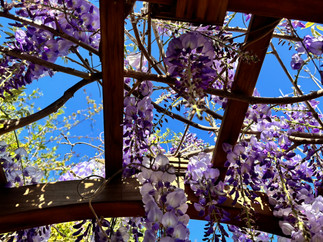GARDEN SURROUNDINGS: Spring Has Sprung In Our Gardens!
- k-england
- Mar 31, 2024
- 3 min read
By Francesca Filanc, for Let’s Talk Plants! April 2024.

Spring has Sprung in our Gardens!
Being that we live in a Mediterranean climate, I seem to always write about wisteria for April because it is drought tolerant once established and gives off so much joy at this time of year not to mention welcomed shade in the summer.
Loving wisteria so much, wisterias have been incorporated into the landscape of every garden where we have lived.
When our girls were growing up, we built a Southwest style home at a previous property. Peter, my late husband, and I designed the home and hardscape, but Pete was happy for me to design the garden. All the wisterias planted at that previous garden were Japanese varieties. We sold that home to a lovely woman who has become a friend. She took beautiful photos in 2015 that she gave me permission to share in this article.

The wonderful thing about the Japanese varieties is that the flowers last longer. They leaf out and flower at the same time. Where I live now, I’ve planted mainly the Chinese variety, Cooke's Purple™ Wisteria. These wisterias flower first, which gives a stunning look, but the flowers don’t last as long as the Japanese varieties.

Another interesting fact is the Chinese variety grows one direction and the Japanese grows the other. One grows clockwise and one grows counterclockwise up the vertical part of a pergola.
The Chinese variety makes a carpet of purple so if you have a vantage point either upstairs in your home or a terraced garden and the structure is on a lower terrace you have the joy of looking down on solid purple this time of year.
Here in Southern California, wisteria either blooms in March or April. This year they are in full bloom at the end of March. Last year they did not bloom until April. The key to having wisteria give such a complete bloom is knowing the correct way to prune them. It is actually simple once you learn how. Check out mom’s book, Pat Welsh’s Southern California Gardening, to teach yourself or, if you have a gardener who climbs up on top of pergolas to do your pruning, you will want to teach him or her how to do it properly.
Only prune in the summertime.
The flowers bloom on the newest wood. Never prune wisteria when they are dormant and never prune them when they are flowering.

First, check if your wisteria is growing clockwise or counterclockwise on the vertical structure going up to the top. Those branches should just be trained the way nature has it laid out for you. There are also long branches that are called twiners. These are the ones that are going to give you amazing shade when in leaf during the summertime. Prune back to two nodules, and next spring you will have blooms from those.
When the wisteria grows to the top of the vertical part of your pergola; it’s important to lay all of the branches vertically to cover the top of the pergola. When the structure is totally covered, then cut back the twiners to a second bud and that will give you all over bloom.
Most people don’t know the correct way to prune and that’s why they don’t get the all-over flowers in the spring. If you remember these simple tips, it is so much fun to prune and look forward to the joy of the following spring.
If you have clay soil, it is important to plant them in raised beds. Once they are established, they are drought tolerant.
In addition to wisteria, yellow Lady Banks roses and Petrea volubilis are also blooming in the garden now.

Enjoy April and all the beauty.
Happy Gardening!
~ Francesca





























